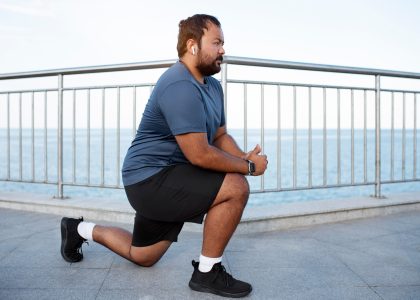Have you ever felt that annoying cramp or numbness in your legs while taking a stroll? It might be more than just fatigue.
If you’ve been diagnosed with Peripheral Artery Disease (PAD), we can understand how difficult it can be to deal with that.
This condition, caused by narrowed arteries limiting blood flow to your extremities, can put a damper on your active lifestyle.
But, there’s nothing to be concerned about as we’re here to guide you through the best exercise routines to manage peripheral artery disease (PAD) like a pro.
So, if you are eager to know why is exercise crucial for managing Peripheral Artery Disease?
Or what types of exercises are safe and effective for individuals with PAD?
We’ve got you covered with a list of beginner-friendly exercises:
What is Peripheral Artery Disease?
Peripheral Artery Disease (PAD) is a condition that affects the blood vessels outside the heart and brain, particularly those supplying the legs and feet. It occurs when fatty deposits, known as plaque, build up in the arteries, narrowing or blocking the blood flow to the extremities.
This reduced blood flow can lead to symptoms such as leg pain, cramping, and weakness, especially during physical activity.
PAD is commonly associated with risk factors like smoking, diabetes, high blood pressure, and high cholesterol.
If left untreated, PAD can increase the risk of serious complications, including infections and difficulty healing wounds in the affected areas.
Best Workouts & Exercise For Peripheral Artery Disease (PAD)
Here are the best exercises to manage the symptoms of peripheral artery disease (PAD):
1. Walking
Walking is an easy way to help treat peripheral artery disease. It gets your blood flowing and strengthens your leg muscles.
Start slow and go faster as you feel comfortable.
Procedure:
- Choose supportive, comfortable footwear.
- Start with a warm-up: march in place or walk slowly for 5 minutes.
- Begin walking at a comfortable pace, gradually increasing speed.
- Maintain an upright posture and swing your arms naturally.
- Aim for at least 30 minutes per session, 3-5 times a week.
- Cool down with a slower pace for the last 5 minutes.
2. Cycling
Riding a bike is one of the best exercises to treat peripheral artery disease. It’s gentle on your joints and helps your blood move better.
Begin with a slow warm-up and pedal a bit faster as you get used to it. Try to do it for 30 minutes, 3 to 5 times a week.
Procedure:
- Adjust the bike seat to a proper height.
- Start with a light warm-up by pedaling slowly for 5 minutes.
- Gradually increase intensity by adjusting resistance or speed.
- Aim for 30 minutes per session, 3-5 times a week.
3. Swimming
Swimming is a great exercise for peripheral artery disease. It’s easy on your joints, and the water gives resistance to your movements, making your muscles work.
Swim for about 30 minutes, 3 to 5 times a week, to help your circulation.
Procedure:
Begin with a few minutes of easy swimming or water walking.
Gradually progress to swimming laps at a comfortable pace.
Aim for 30 minutes per session, 2-4 times a week.
Cool down by swimming slowly or treading water.
4. Elliptical Training
Using an elliptical machine is good for treating peripheral artery disease. It’s like a mix of walking and cycling, but with less impact on your joints.
Start with a slow warm-up and increase the intensity.
Procedure:
- Start with a 5-minute warm-up at a low intensity.
- Use the elliptical machine, maintaining proper posture.
- Gradually increase intensity or resistance.
- Aim for 20-30 minutes per session, 4-6 times a week.
- Cool down with a slower pace for the last couple of minutes.
5. Water Aerobics
Water aerobics in a shallow pool is a fun workout for peripheral artery disease (PAD). The water’s buoyancy supports your body, making it easier on your joints.
Do it for about 30 minutes, 3 to 5 times weekly, to improve your blood flow.
Procedure:
- Join a water aerobics class or perform exercises in a shallow pool.
- Warm up with gentle movements for 5 minutes.
- Engage in a variety of water aerobics exercises.
- Aim for 30 minutes per session, 3-5 times a week.
- Cool down with gentle movements in the water.
6. Leg Exercises (Leg Lifts, Knee Extensions)
Simple leg exercises, like lifting your leg or extending your knee, help treat peripheral artery disease.
Sit or lie down comfortably and do 10 to 15 reps for each leg. Increase the reps as you get stronger.
Procedure:
- Sit or lie down in a comfortable position.
- Lift one leg at a time or extend the knee, holding briefly.
- Perform 10-15 repetitions for each leg.
- Gradually increase repetitions and sets as tolerated.
7. Stationary Biking
Using a stationary bike is a good exercise for peripheral artery disease. It’s low-impact and helps with blood circulation.
Start slow, pedal faster gradually, and aim for 20 to 30 minutes, 3 to 5 times a week.
Procedure:
- Set up the stationary bike with proper seat height.
- Begin with a 5-minute warm-up at a low intensity.
- Increase resistance or speed gradually.
- Aim for 20-30 minutes per session, 3-5 times a week.
- Cool down with a slower pace for the last 4-5 minutes.
8. Tai Chi
Tai Chi is a slow, controlled movement exercise that can help treat peripheral artery disease. It improves balance and flexibility.
Practice for 20 to 30 minutes, 3 to 5 times weekly, to benefit your circulation.
Procedure:
- Learn basic Tai Chi movements from a qualified instructor.
- Practice slow, controlled movements, focusing on balance.
- Aim for 20-30 minutes of Tai Chi, 3-5 times a week.
9. Yoga
Yoga is a good exercise for the treatment of peripheral artery disease. It involves gentle stretches and helps with strength.
Aim for 20 to 30 minutes, 2 to 3 times a week, to support your overall health.
Procedure:
- Choose beginner-friendly yoga poses.
- Focus on gentle stretching and strengthening exercises.
- Aim for 20-30 minutes per session, 2-3 times a week.
10. Strength Training (with Low Weights and High Repetitions)
Strength training with light weights or resistance bands is beneficial for peripheral artery disease.
It helps strengthen your muscles without putting too much strain on your body. Do 2 to 3 sessions a week with 15 to 20 reps for each
Procedure:
- Use light weights or resistance bands.
- Perform 1-2 sets of 15-20 repetitions for each exercise.
- Include exercises targeting major muscle groups.
- Aim for 2-3 strength training sessions per week.
Final Remarks
Incorporating the right exercises into your routine can be a great way in managing Peripheral Artery Disease.
Don’t let PAD dictate your pace; instead, take charge of your health with targeted workouts that promote better blood flow and overall well-being.
And always consult with your healthcare professional before starting any new exercise regimen, especially if you have a medical condition like PAD.




